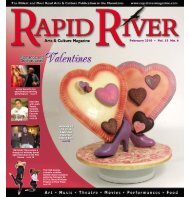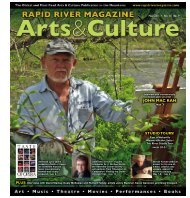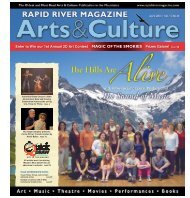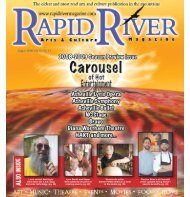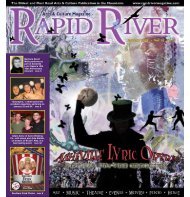Get Tickets Now to the Season's Best Performances - Rapid River ...
Get Tickets Now to the Season's Best Performances - Rapid River ...
Get Tickets Now to the Season's Best Performances - Rapid River ...
You also want an ePaper? Increase the reach of your titles
YUMPU automatically turns print PDFs into web optimized ePapers that Google loves.
R A P I D R I V E R A R T S & C U L T U R E<br />
Until relatively recently, Cesare<br />
Pavese (1908-1950) was<br />
primarily remembered as a<br />
novelist, and indeed he wrote<br />
some of <strong>the</strong> finest novels produced<br />
during and immediately after<br />
<strong>the</strong> short reign of Fascism in Italy.<br />
Such Pavese novels as The Moon<br />
and <strong>the</strong> Bonfires<br />
(1950) exposed <strong>the</strong><br />
difficulties of being a “regional” writer<br />
in a nation whose leaders were attempting<br />
<strong>to</strong> suppress regional identity<br />
and individual dignity <strong>to</strong> create a more<br />
centralized, nationalistic society.<br />
Pavese’s narratives were characterized<br />
by a specific and vivid sense of<br />
place (Turin and <strong>the</strong> countryside near<br />
that city), and his use of language was<br />
colloquial yet precise. As a measure<br />
of <strong>the</strong> power and universality of his<br />
writing, most of Pavese’s novels are<br />
available <strong>to</strong>day in English translations<br />
(alas, his remarkable nonfiction work<br />
Dialogues with Leuco<br />
and many of his<br />
short s<strong>to</strong>ries are not currently in-print<br />
in English-language editions).<br />
Significantly, <strong>the</strong> literary qualities<br />
that infused Pavese’s novels were first<br />
realized in poems composed during<br />
<strong>the</strong> mid-1930s, such as his masterful<br />
narrative poem “South Seas.”<br />
The availability of Pavese’s poetry<br />
in English can be traced <strong>to</strong> William<br />
Arrowsmith’s 1976 translation of<br />
<strong>the</strong> Italian author’s debut volume of<br />
poems, Lavorare stanca (published in<br />
1936, with an expanded edition issued<br />
in 1943).<br />
Translated by Arrowsmith as<br />
Hard Labor, this book featured Pavese’s<br />
hypnotic, mysterious s<strong>to</strong>ry-poems,<br />
transformed by Arrowsmith in<strong>to</strong><br />
credible English-language versions<br />
that were at <strong>the</strong> same time understated<br />
and luminous. Ano<strong>the</strong>r attribute of<br />
<strong>the</strong> book was its introduc<strong>to</strong>ry essay,<br />
in which Arrowsmith postulated that<br />
Pavese’s tragic worldview was an<br />
inevitable outcome of his struggles <strong>to</strong><br />
survive in an increasingly repressive<br />
society (<strong>the</strong> Italian authorities, citing<br />
Pavese’s skeptical attitude <strong>to</strong>ward Fascism,<br />
confined <strong>the</strong> author <strong>to</strong> exile for<br />
poetry & poets<br />
Cesare Pavese’s Poetry: A Tale of Two Transla<strong>to</strong>rs<br />
Poetry<br />
Contest<br />
Winners<br />
Winning poems<br />
will be published<br />
in <strong>the</strong> March 2011<br />
issue of <strong>Rapid</strong><br />
<strong>River</strong> Magazine.<br />
three years). In his introduc<strong>to</strong>ry essay,<br />
Arrowsmith also traced <strong>the</strong> influence<br />
on Pavese — who translated in<strong>to</strong> Italian<br />
a number of English-language literary<br />
classsics — of a range of English<br />
and American authors.<br />
Arrowsmith’s powerful translations<br />
attracted <strong>the</strong> attention of American<br />
readers <strong>to</strong> Pavese’s poetry, yet Hard<br />
Labor<br />
would eventually fall out-ofprint.<br />
Ano<strong>the</strong>r transla<strong>to</strong>r, Geoffrey<br />
Brock, would fill <strong>the</strong> void by offering<br />
new translations of Pavese’s poetry.<br />
Cesare Pavese<br />
Unlike Arrowsmith, who focused<br />
exclusively on Lavorare stanca, Brock<br />
translated all of Pavese’s poetry, including<br />
both <strong>the</strong> 1936 and 1943 editions of<br />
Lavorare stanca<br />
(which Brock retitles<br />
as Work’s Tiring) as well as Pavese’s<br />
later poetry (including <strong>the</strong> important<br />
sequence of poems “Death Will Come<br />
and Will Have Your Eyes”).<br />
Brock’s interpretations of Pavese<br />
— published as Disaffections: Com-<br />
plete Poems 1930-1950<br />
(Copper Can-<br />
yon Press, 2002) — complemented<br />
ra<strong>the</strong>r than imitated Arrowsmith’s<br />
translations. Brock confronted <strong>the</strong><br />
relationship of his translations <strong>to</strong><br />
Arrowsmith’s texts:<br />
“One of <strong>the</strong> strengths of <strong>the</strong> Arrowsmith<br />
versions is that <strong>the</strong>y<br />
emerge in<strong>to</strong> English with an<br />
undeniable energy and sensibility<br />
of <strong>the</strong>ir own. For my taste,<br />
such translations are nearly always<br />
preferable <strong>to</strong> blandly literal versions,<br />
which in <strong>the</strong>ir loyalty <strong>to</strong> <strong>the</strong><br />
letter often betray <strong>the</strong> spirit. Still,<br />
Arrowsmith’s versions sometimes<br />
betray <strong>the</strong> spirit of <strong>the</strong> poems in<br />
o<strong>the</strong>r ways. They are, for example,<br />
chattier and less measured<br />
(in all senses of that word) than<br />
Pavese’s original poems, whose<br />
tight-lipped rhythm becomes an<br />
integral part of <strong>the</strong> experience of<br />
reading <strong>the</strong>m, as it apparently was<br />
of <strong>the</strong> experience of writing <strong>the</strong>m.<br />
I have felt obligated, in my translations,<br />
<strong>to</strong> try <strong>to</strong> create a similar<br />
rhythmic experience.”<br />
BY TED OLSON<br />
It is difficult <strong>to</strong> include in this<br />
short column an adequate example<br />
of Pavese’s poetry because his poems<br />
tend <strong>to</strong> be lengthier than typical modern<br />
lyric poems and often involve narrative<br />
elements that make little sense<br />
when quoted out of context. Here’s<br />
<strong>the</strong> entirety of one minor Pavese<br />
poem, “Sketch of a Landscape,” taken<br />
from Brock’s book (page 281):<br />
The pigs and <strong>the</strong> girls with sacks on <strong>the</strong>ir heads<br />
walk through <strong>the</strong> streets: droplets of rain<br />
are whipped by <strong>the</strong> wind as <strong>the</strong>y fall. Each puddle,<br />
with its pale blue-gray face, smiles at <strong>the</strong> clouds.<br />
In <strong>the</strong> piazza <strong>the</strong> people can’t seem <strong>to</strong> argue,<br />
<strong>the</strong>y accommodate everyone, and goats and hogs,<br />
along <strong>the</strong> <strong>to</strong>wn walls. Where mortar has crumbled,<br />
<strong>the</strong>re rises <strong>the</strong> solid flowering mass of a tree.<br />
Granted that Brock’s Pavese<br />
volume received several prestigious literary<br />
awards for excellence in translation,<br />
I find that when wishing <strong>to</strong> read<br />
Pavese’s poetry, I — as one who has<br />
marveled for years at Arrowsmith’s<br />
passionate take on Lavorare stanca<br />
— invariably locate my wea<strong>the</strong>red<br />
copy of that earlier book.<br />
Yet Brock should be applauded<br />
for recreating <strong>the</strong> distinctively structured<br />
prosody of Pavese’s original<br />
Italian poems in accurate Englishlanguage<br />
versions. English-speaking<br />
poetry aficionados should be grateful<br />
<strong>to</strong> Brock for making all of Pavese’s<br />
poems available within one beautifully<br />
designed and affordable edition.<br />
Ted Olson is <strong>the</strong> author<br />
of such books as<br />
Breathing in Darkness:<br />
Poems<br />
(Wind<br />
Publications, 2006)<br />
and Blue Ridge Folklife<br />
(University Press of<br />
Mississippi, 1998) and<br />
he is <strong>the</strong> edi<strong>to</strong>r of numerous books,<br />
including CrossRoads: A Sou<strong>the</strong>rn<br />
Culture Annual<br />
(Mercer University<br />
Press, 2009). His experiences as<br />
a poet and musician are discussed<br />
on www.windpub.com/books/<br />
breathingindarkness.htm.<br />
Poets who would like for <strong>the</strong>ir poetry <strong>to</strong> be<br />
considered for a future column may send<br />
<strong>the</strong>ir books and manuscripts <strong>to</strong> Ted Olson,<br />
ETSU, Box 70400, Johnson City, TN<br />
37614. Please include contact information<br />
and a SASE with submissions.<br />
26 February 2011 — RAPID RIVER ARTS & CULTURE MAGAZINE — Vol. 14, No. 6




